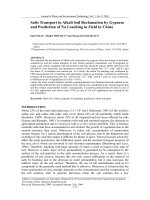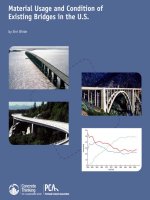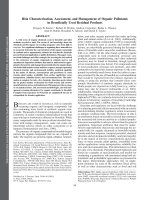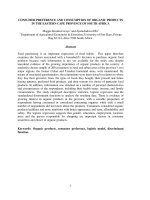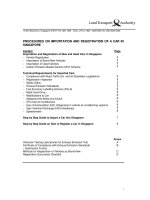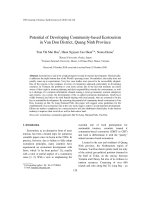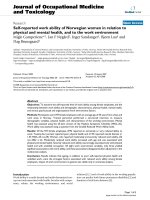Coral degradation and ability of rehabilitation of coral reefs in co to archipelago, quang ninh province, vietnam
Bạn đang xem bản rút gọn của tài liệu. Xem và tải ngay bản đầy đủ của tài liệu tại đây (886.98 KB, 6 trang )
Deep-Sea Research II 96 (2013) 50–55
Contents lists available at ScienceDirect
Deep-Sea Research II
journal homepage: www.elsevier.com/locate/dsr2
Coral degradation and ability of rehabilitation of coral reefs
in Co To Archipelago, Quang Ninh province, Vietnam
Nguyen Dang Ngai n, Nguyen Duc Cu, Dao Anh Tuyet
Institute of Marine Environment and Resources (IMER), Vietnam Academy of Science and Technology (VAST), 18 Hoang Quoc Viet Str., Cau Giay Distr., Hanoi,
Viet Nam
art ic l e i nf o
a b s t r a c t
Available online 25 April 2013
Serious degradation of coral reefs in the Co To Archipelago occurred from 2002 to 2006. Nearly 80% of
the species and over 90% of living coral cover were lost and some reefs were completely dead. Currently,
the highest coral cover is only 7.5% where previously most of the reefs had over 50% live coral cover. The
cause of the reef degradation has been identified to be residues of cyanide used by local fishermen for
fishing on reefs. To overcome the consequences transplantation corals on natural and artificial shelters
were attempted. Survival rate on artificial shelters was 88.3% after 2 years and growth rate averaged
2.3 cm/year. Transplanted corals on natural shelters had lower survival rate, 55.9%. The natural recovery
of coral on degraded reefs was also monitored periodically in this study. No coral recruitment was seen
on completely dead reefs whereas there was little new coral recruitment on reefs with some remaining
live corals.
& 2013 Elsevier Ltd. All rights reserved.
Keywords:
Coral degradation
Recovery
Growth rate
Transplant
1. Introduction
Serious degradation has been observed on many coral reefs
worldwide. For more than a decade area, coverage and number of
species have been reduced (McClanahan, 2002; Wilkinson, 2004,
2008; Lough and Van Oppen, 2009). Many causes for this decline
have been described from different regions, e.g. increasing seawater
temperature (Anthony et al., 2007), sedimentation (Hernandez et al.,
2009), freshwater runoff (Tuan et al., 2008), dynamite fishing
(McManus et al., 1997). Following these phenomena some reefs can
self-recover (Hughes et al., 2010; Sheppard et al., 2008; Halford et al.,
2004) some need help from artificial restoration and others were
unable to restore because substrate or environment was not suitable
for coral growth (Fabricius, 2005; Scheffer et al., 2001, Hughes, 1994,
Hughes et al., 2010). Application of transplanting on artificial and
natural shelters for coral restoration has been successful in many
areas of the world (Clark and Edwards, 1994; Rinkevich, 2005; Quan
and Ngai, 2008). The restoration methods included: physical, biological, and dual restoration (combination of biological and physical
restoration) (Job et al., 2003). Depending on the specific conditions of
each area the most suitable methods for rehabilitation may be
chosen. The most widely used methods are the reefball and natural
shelters (Rinkevich, 2000).
Almost all coral reefs in Co To Islands died between 2002 and
2006. In recent years, though the water seems clean, the bottom
substrate is dead coral rock and sand and very little coral has
recruited here. The purpose of this study was to examine the
natural recovery of coral on degraded reefs and carry out experiments to test for survival and growth rate of corals on natural and
artificial shelters in order to develop a management plan for
effective protection and restoration of coral reefs.
2. Research methods
2.1. Study area
Co To Archipelago belongs to Quang Ninh province, in northern
Vietnam, about 50 km from the mainland (20156′00″–21104′00″N
and 107144′00″–107152′00″E), with more than 15 islands. The total
area of Co To Islands is 46.2 km². A population of 5195 people (in
2006) live mainly on capture fishery and agriculture. This area has
favorable natural conditions for reef development such as: warm and
clear water, high salinity, hard substrate. Therefore, coral ecosystems
are developed with over 100 species of hard corals, high coverage
and the biggest reef in northern Vietnam. The Islands have high
biodiversity including many valuable and commercial species for
example reef fishes, abalone, sea cucumber, pearl oyster. Additionally
this area is an important fishing ground and seed is dispersed to
nearby coastal areas (WWF, 1994). Therefore, Co To Islands have been
considered for a list of 15 marine protected areas in Vietnam.
2.2. Method of determining the status and degradation of coral
n
Corresponding author.
E-mail addresses: , (N.D. Ngai).
0967-0645/$ - see front matter & 2013 Elsevier Ltd. All rights reserved.
/>
The overall status of coral reefs in the Co To was surveyed by
using a small boat pulling the observer on the water surface above
N.D. Ngai et al. / Deep-Sea Research II 96 (2013) 50–55
the reefs to observe and record the data on living coral, dead coral,
soft coral and macro-benthos (English et al., 1997) and then select
sites to beused for specific survey by point transect method to get
data on each component of substrate, coral fishes and other
benthic communities (Hodgson et al., 2004). During the survey
we focused on the status of coral death and the cause of death.
− Local fishermen were internviewed to find out the cause of
death of corals in this area. Questionnaires focused on production, the target species of exploitation, exploitation methods,
fishing gears, etc.
− The environmental parameters were periodically monitored at
three study sites (Trau Khe, Thanh Mai, Dang Van Chau) in 2008,
2009 and 2010. Each year the three sites were monitored for three
days. Measurement directly and samples for analysis were
collected at the surface and bottom 6 times/24 h. Field parameters
such as salinity were measured by refractometer, temperature
and DO was measured by a DO meter, pH was measured by pH
meter OKATON, transparency was measured by secchi disk. The
samples for nutrient, cyanide, pesticide and other water quality
measurements were collected at each site at both surface and
bottom layer, fixed by suitable chemicals and analyzed in the
laboratory. In order to assess status of water environmental
quality, measurements were compared to promulgated standards
of Vietnam and Asian countries (Table 1).
2.3. Method of monitoring the natural recovery
− Growth of natural corals was monitored by attaching labels on
several colonies and measures them periodically. A total of 12
coral colonies were marked and measured one time a year by
fiberglass ruler over colony at each site from 2008 to 2010.
− The recruitment of coral juveniles was monitored and observed
on transect lines with length of 20 m at 5 reefs (Fig. 1), observing
and counting the number of small coral colonies, less than 5 cm
of coral, within 2.5 m on each side of the transect. The reefs were
selected for monitoring at different places (in and outside Co To
bay, on reefs with living coral and without living coral).
2.4. Transplanting coral
Two types of shelters were applied for transplanting corals
− Concrete reefballs (Reef Ball Foundation, 2008; Precht, 2006)
were designed for transplanting coral colonies with measurements: 1 m in diameter, 0.8 m high, with 14–16 holes, diameter
of holes from 5 to 12 cm of which eight holes were used for
planting corals and the remaining 6–8 holes were left for
organisms to get in and out. The reefball can be placed on
sand or rubble bottom. Coral pieces were tied on the shelter by
fishing line and then the reefball was dropped into the sea.
Table 1
Water quality criteria for coastal environment and aquaculture.
(Source: Ministry of Environment and Resources, 2008).
Parameters
Unit
Vietnam
ASEANa
pH
Dissolved oxygen (DO)
TSS
COD
BOD5
Cyanide
Ammonium (NH4+–N)
Nitrate (NO3–N)
Nitrite (NO2–N)
Phosphate (PO43−–P)
mg/L
mg/L
mg/L
mg/L
mg/L
mg/L
mg/L
mg/L
mg/L
6.5–8.5
≥5
50
3
4–6
0.005
0.1
2
0.01
0.1
–
4
10% increase
–
–
0.007
0.07
0.06
0.055
0.015
a
ASEAN ¼ Association of South East Asian Nations.
51
− Natural shelter: This kind of shelter took advantage of the dead
coral rock. Steel nails about 15 cm long and pointed at one end
were driven 5–10 cm into coral rock, and coral fragments were
tied on by plastic rope.
− Coral seed was taken from donor reefs around the Co To area,
most of them were massive, encrusting and laminae. No
branching corals were included because they were completely
dead in the area. Coral seed was placed in water containers
with aero pump. Coral colonies were then cut into small pieces
with a size of 5–15 cm.
3. Results and discussion
3.1. The degradation and current status of coral in Co To
Co To Archipelago has natural and environmental conditions
suitable for the growth of coral. A total of 114 species, 37 genera
and 13 families have been found in the area (WWF, 1994).
According to WWF′s experts, at that time, corals had high species
richness and abundance, and the most common species belonged
to the branching coral genus Acropora, which are rapid growing
and dominant on reef. Hong Van reef was the largest coral reef not
only in Co To but also in the North of Vietnam with a length of
5 km and 1 km in width with high coral cover. The area around the
Dang Van Chau Island and southwest Thanh Lan Island had the
highest coral coverage (classified as very good and excellent reef).
Biological resources on the reefs were also very rich, notably sea
cucumbers, cone snails, pearl oysters, and abalone.
When the survey was repeated in 2003 on most reefs many
newly dead corals that still retained their shape were seen, most of
which were branching corals. Live coral cover and species number
were reduced when compared to previous results. At the same
time the number of species of valuable economic resources, sea
cucumber and abalone were also greatly reduced.
In 2008 most coral reefs in this area had died completely, only a
few reefs with sparse coral cover were left. Generally loss was
about 80% of the number of species and about 90% of the reef area
(Fig. 2). This is the greatest and fastest degradation recorded in the
coastal areas of Vietnam. On the reef only coral rock and sand was
found, some covered with seaweed. The Hong Van, Bac Van reef,
which has been considered the biggest and most beautiful reef in
the north of Vietnam was now completely dead, and the other
reefs around the island Co To Lon, Dang Van Chau, Khe Trau were
in the same condition. Especially, no branching corals were found
in the region—the most common species in the Co To before. Some
surviving corals were massive, encrusting and laminae that were
scattered in the south of Khe Trau, Thanh Mai, Dang Van Chau,
Co To Con with a very low density. Distance between remaining
colonies was between 3 and 4 m, and colonies were small size,
about 20–40 cm.
The number of coral species in the Co To at present is very low,
in total 24 species of hard corals and one species of soft coral were
found. The distribution of species varied among reefs, most reefs
had only single species. In Dang Van Chau Island the only species
were Turbinaria peltata and Goniopora lobata, in Thanh Mai it was
Plesiastrea versipora. The North Trau Khe was more varied, species
included Galaxea, Favia, Goniopora, Porites but Goniastrea was most
abundant. At this time six reefs were surveyed for coral cover but
two reefs had no living coral (Hong Van and North Khe Trau), two
reefs were very sparse in living coral of small size (Dang Van Chau
and Thanh Mai). Coral cover was higher south of Khe Trau and Co
To Con Island (from 3.5 to 7.5%), most colonies were small. On all
reefs the coverage of dead coral was high, 40–85% (Table 2, Fig. 4).
52
N.D. Ngai et al. / Deep-Sea Research II 96 (2013) 50–55
Fig. 1. Location of Co To Archipelago and studied sites.
70
Living coral cover (%)
60
50
40
30
20
10
0
In 1994
In 2003
In 2008
Fig. 2. Decrease of living coral cover over time.
3.2. Causes of coral degradation
To find the cause of coral death, the results of field studies,
monitoring of environmental factors and information from fishermen on the archipelago have been combined:
Analysis of water quality in this area showed that the temperature over two seasons ranged from 21.1 to 31 1C, average 25.0 1C in
surface water and at the bottom ranged from 21.3 to 30.3 1C,
average 24.3 1C. Salinity was high and relatively stable, ranging
from 30.0 to 33.0‰ for surface water and from 31.5 to 33.0‰ at the
bottom; pH ranged from 8.00 to 8.36. Dissolved oxygen concentration was high, surface values ranged between 6.38 and
6.64 mgO2/L, average 6.49 mgO2/L, bottom values from 5.79 to
6.42 mgO2/L, average 6.14 mgO2/L. Turbidity was low, surface layer
ranged from 1.00 to 6.61 NTU, 3.72 NTU on average, and bottom
range from 2.19 to 14.22 NTU, average 7.05 NTU.
Concentrations of nutrients (ammonium, phosphate, nitrate,
nitrite), organic matter (BOD5, COD), pesticide were within acceptable limits according to Vietnam′s water quality standards. The
most notable exception was the concentration of cyanide in the
water, which was very high, sometime exceeding the permitted
standards (5 μg/L). Specifically, at the monitoring stations the
cyanide concentration ranged from 4.13 to 5.72 μg/L, average
4.95 μg/L, bottom concentration higher than in the surface layer.
While cyanide concentration in water based on standard from
developed countries is 1 μg/L. Cyanide is one of the most poisonous chemicals and is highly toxic to both humans and animals,
causing death even in trace amounts. Cyanide does not occur in
nature, but is created by technology and industry and mostly
applied in large volumes for ferrous metallurgy such as gold ore
and metal plating technology (Fig. 3).
The information obtained from interviewing fishermen on the
island show that during the years 2002–2006 about 100 diving
boats would regularly exploit fishes around the islands. Especially
they used cyanide to catch fish on the reefs. There are no
monitoring data from this period, but each diver used several to
10 kg of cyanide powder per day. Residue of cyanide in the water
has killed high numbers of corals, particular sensitive species like
Acropora. In recent years fishermen have not used cyanide to catch
fish so the trend of cyanide concentration in the water should be
going down but is still high.
In the survey trips we observed dead corals still retaining their
shapes and unbroken unlike those killed by explosion or strong
waves. Combined with the above findings it can be concluded that
dead coral in Co To is due to the exploitation of marine resources
by toxic cyanide in the period 2002–2006. Presently the fishermen
do not use this method because fish stocks have been depleted
and coral ecosystems have been killed so the fishes have lost their
habitat.
3.3. Natural recovery
Results of monitoring the coral recovery through recruitment of
juveniles at five reefs have been compiled in Table 3. Reefs with
53
N.D. Ngai et al. / Deep-Sea Research II 96 (2013) 50–55
35
30
25
20
15
10
5
0
Mar Jul 2008 Dec
2008
2008
Mar
2009
ToC
Aug
2009
Dec
2009
DO (mg/l)
Mar
2010
pH
Sep
2010
S‰
Fig. 5. Settlement of juveniles on bottom.
60
50
40
30
20
10
20
p
Se
ar
20
10
10
09
M
ec
D
20
Au
g
ar
N - NO2-(µg/l)
N - NH4+ (µg/l)
20
09
09
20
08
M
D
ec
20
00
l2
Ju
M
ar
20
08
8
0
N - NO3-(µg/l)
P - PO43-(µg/l)
7
Fig. 6. Coral colonies transplanted on reefball after 3 months.
6
5
Table 2
Coverage (%) of substrate on the reef in 2008.
4
3
Reef name
Hard
coral
Soft
coral
Dead
coral
Rock Sand Rubble Sponge
Hong Van
Thanh Mai
Dang Van Chau
Northwest Khe
Trau
South Khe Trau
Co To Con
0
0.6
0.6
0
0
0
0
0
40
64.4
84.4
80
0
0
0
0
58
35
15
20
0
0
0
0
2
0
0
0
3.5
7.5
0
0
52
68.7
0
0
44.5
22.5
0
1.3
0
0
2
1
0
Mar Jul 2008 Dec
2008
2008
BOD5 (mg/l)
Mar
2009
Aug
2009
COD (mg/l)
Dec
2009
Mar
2010
Sep
2010
CN-(µg/l)
Fig. 3. Concentration of environmental parameters monitored at field from
2008–2010.
Fig. 4. Dead coral reef in Co To Islands.
few live coral colonies had low settlement rate from 1–2 colonies/
year, while reefs which had more living coral had higher rates of
coral recruitment from 23–28 colonies/100 m2/year (Fig. 5). Three
reefs with no living corals had no recruitment of juvenile corals
after two monitoring years as seen in North Khe Trau, Thanh Mai
and Dang Van Chau. The most likely reason for this is that there
was no in-situ source of larvae so that they must depend on ex-situ
larvae supply and only small coral areas are available nearby. On
the other hand these reefs may be seriously affected by cyanide in
sediment and dead coral rock and the available coral larvae may
have died after settlement on bottom.
The natural recovery of the coral colonies is still going on at
almost all of the surveyed sites through slow growth of the
surviving coral colonies. Monitoring the growth rate of some coral
colonies on reefs showed that growth of coral in this area was the
same as in other areas and as growth of corals in general. Most
corals have growth rates from 2 to 3 cm/year (Table 4). The lowest
growth rate is about 1 cm/year in the genus Porites. Particularly
slow growth is seen in the species Pseudosiderastrea tayami which
only grows 0.5 cm/year due to the small size of this species, the
largest colony having a maximum size of only about 16 cm (Veron,
2000).
Although concentration of cyanide in the water remains high
the natural recovery of coral reefs through growth of remaining
54
N.D. Ngai et al. / Deep-Sea Research II 96 (2013) 50–55
colonies and recruitment of new juveniles still occurs at slow
speed. Unfortunately, the branching coral species which have
rapid growth rates do not exist anymore in the Co To region and
thus rehabilitation will happen slowly by massive, encrusting,
laminae corals.
3.4. Artificial restoration on shelters
A total of 130 reefballs were used for transplanting coral at
3 sites (Fig. 6). Survival rate and growth of corals were monitires
on 29 reefballs with 231 colonies. The survival rate of corals
growing on reefballs was very high, reaching over 95% in the first
year and 88.3% after 2 years (Table 5). Coral colonies died mainly
from shock during the separation processing into smaller colonies
and some colonies were lost from the shelters due to poor
attachment in the first year. In the second year the transplanted
Table 3
Number of juvenile coral settlement on reef.
Site
In 8/2008
In 9/2009
In 9/2010
North Khe Trau
South Khe Trau
Dang Van Chau
Thanh Mai
Co To Con
0
2
0
0
27
0
1
0
0
28
0
0
0
0
23
Table 6
Survival ratio of transplanted coral on natural shelters.
Table 4
Measurement of natural coral colonies (cm).
Species name
Origin
size
8/2008
Increase
9/2009a
Increase
9/2010a
Goniopora lobata
18.5
21
57
50
68
39
30
25.5
31
7.5
2.5
2.5
3
2.5
1
3
2.5
2.5
3
0.5
2.5
2.5
3
3
1
2.5
2
2.5
2.5
0.5
22
17
2.5
2.2
2
2
Turbinaria peltata
Porites lutea
Pavona decussata
Goniastrea favulus
Pseudosiderastrea
tayami
Plesiastrea versipora
a
coral had grown normally, they were adhering to shelters and
covering plastic rope tightly. Unfortunately, a bloom of the coral
predator, the snail Drupella sp., occurred in the Co To area. They
often assemble in small groups of 5–10 individuals and eat coral
tissue and therefore survival rate of coral was reduced in the
second year.
For coral colonies that were transplanted on coral rock by using
steel nails driven into the substrate and tied by plastic rope, about
93 colonies were monitored for survival rate. The fraction of
surviving coral was low, the main reason being that fixation of
coral pieces on to shelter was not tight enough and tying was more
difficult for massive and laminae shape when tying under water.
On the other hand the appearance of the snail Drupella was the
biggest threat to the new coral transplanted on this substrate
because they are easy to access and the injuries of the coral
colonies after the separation process attracted the snail predators.
The rate of survival of these corals was 55.9% after 2 years
(Table 6).
Therefore, artificial coral restoration can be carried out on a
large scale on the degraded reefs in the Co To archipelago both on
natural and artificial shelters. Growth of corals on the reefball has
many advantages when compared to the natural shelter: high
survival rate, easier to handle, lower rate of detachment and
predation by snails. When carrying out transplanting on large
scale it should be noted that the donor reefs are now sparse in live
corals so that transplantation may affect the donor reef, and the
Name
Number
of coral
colony
Average
measurement
(cm)a
Growth
rate/
year
(cm)
Number of
colony eaten by
predator and
detached
Survival
ratio (%)
Plesiastrea
versipora
Echinophyllia
aspera
Goniopora
columna
Turbinaria
peltata
Galaxea
fascicularis
Goniastrea
favulus
33
11.2
2.46
16
51.5
6
9.4
2.95
4
33.3
12
2.4
1
50
34
10.5
2.5
11
67.6
1
8.2
1
0.0
17
9.28
2.75
8
52.9
2.612
41
55.9
Total
a
Measured by fiberglass tape over colonies.
2
93
10.1
Measured by fiberglass tape over colonies.
Table 5
Ratio (%) of live coral transplanted on reefball.
Species name
Echinophyllia aspera
Galaxea fascicularis
Goniopora columna
Pavona decussata
Goniastrea favulus
Porites lutea
Turbinaria peltata
Favites sp
Plesiastrea versipora
Total
a
Growth rate/year
Average
measurement (cm)a (cm)a
Number of colony
eaten by predator
and detached
Survival ratio (%)
21
3
13
2
42
2
79
1
68
9.1
9.96
9.3
12.5
9.42
11.24
10.9
10.5
10.9
2.7
2.6
2.4
2.15
2.58
1
2.75
2.1
2.66
2
1
0
1
9
1
11
0
2
90.5
66.7
100.0
50.0
78.6
50.0
86.1
100
97.1
231
10.4
2.3
27
88.3
Number of coral
colony
Measured by fiberglass tape over colonies.
N.D. Ngai et al. / Deep-Sea Research II 96 (2013) 50–55
outbreak of the predator snail Drupella sp. is the biggest threat to
transplanted corals.
4. Conclusions
The degradation of coral reefs in the Co To Archipelago was
very serious. It occurred mainly in the period from 2002 to 2006
and has reduced the number of species from 127 to 25. Nearly 80%
of species, 90% of live coral cover, and 100% of some reefs were
lost. Currently the highest coral coverage in the Co To area is 7.5%
whereas previously most of the reefs had coverage of at least 50%.
Research results have identified the cause of coral death to be coral
fishermen using cyanide poison to catch coral fishes for a long
time. Residues of cyanide also killed coral on a large scale
especially branching coral Acropora that are very sensitive to
environmental changes has been killed completely. Monitoring
showed that the natural recovery of corals is taking place slowly.
On the completely dead reefs there is no recovery of corals due to
no source of larvae within these reefs, whereas on some living
coral reefs the coral recruitment is high. Restoration of corals by
transplanting on two types of shelters resulted in significant
differences in survival rates. For corals growing on the reefballs
survival rate was higher than on natural substrates (88.3% and
55.9% respectively) because it was easier to tie the massive and
laminae corals on reefballs than on natural shelters, which
reduced the accessibility of attack of predator. This opens up
prospects for artificial restoration of coral reefs in this area if we
can control the amount of predation by the snail Drupella sp.
Acknowledgments
This work is supported by KC.09.07/11-15 program (Littoral
ecosystems in the north of Vietnam Project) and People′s Committee of Quang Ninh province. We are very grateful to all our
colleagues for their hard work in the field to install experiments
and monitor water environment in Co To Islands. We also thank
Prof. Jing Zhang, who is leader of CoReCAP Project (IOC/WESTPAC)
encouraged us to submit this paper. And many thanks to Dr. Kathe
Rose Jensen for editing the English language. We also thank the
anonymous reviewers for their pertinent and helpful comments.
References
Anthony, K.R.N., Connolly, S.R., Hoegh-Guldberg, O., 2007. Bleaching, energetics,
and coral mortality risk: effects of temperature, light, and Sediment regime.
Limnol. Oceanogr. 52 (2), 716–726.
Clark, S., Edwards, A.J., 1994. Use of artificial reef structures to rehabilitate reef flats
degraded by coral mining in the Maldives. Bull. Mar. Sci. 55, 724–744.
55
English, S., Wilkinson, C., Baker, V., 1997. Survey Manual for Tropical Marine
Resources. Australian Instistute of Marine Science.
Fabricius, K.E., 2005. Effects of terrestrial runoff on the ecology of corals and coral
reefs: review and synthesis. Mar. Pollut. Bull. 50, 125–146.
Halford, A., Cheal, A.J., Ryan, D., Williams, D.M., 2004. Resilience to large-scale
disturbance in coral and fish assemblages on the Great Barrier Reef. Ecology 85,
1892–1905.
Hernandez, R., Sherman, C., Weil, E., Yoshioka, P., 2009. Spatial and temporal
patterns in reef sediment accumulation and composition, southwestern insular
shelf of Puerto Rico. Caribb. J. Sci. 45 (2–3), 38–150.
Hodgson, G., Kiene, W., Mihaly, J., Liebeler, J., Shuman, C., Maun, L., 2004. Reef
Check Instruction Manual: A Guide to Reef Check Coral Reef Monitoring,
Published by Reef Check, Institute of the Environment, University of California
at Los Angeles.
Hughes, T.P., Graham, N.A.J., Jackson, J.B.C., Mumby, P.J., Steneck, R.S., 2010. Rising to
the challenge of sustaining coral reef resilience. Trends Ecol. Evol. 25, 633–642.
Hughes, T.P., 1994. Catastrophes, phase-shifts, and large-scale degradationof a
Caribbean coral-reef. Science 265, 1547–1551.
Job, S., Schrimm, M., Morancy, R., 2003. Reef Restoration: Practical guide for
management and decision-making. Carex Environnement, Ministère de l′
Écologie et du Développement Durable. IFRECOR, 32p.
Lough, J.M., Van Oppen, M.J.H., 2009. Coral Bleaching: Patterns, Processes, Causes
and Consequences. Ecological Studies, 205. Springer178.
McClanahan, T.R., 2002. The near future of coral reefs. Environ. Conserv. 29,
460–483.
McManus, J.W., Reyes, R.B., Cleto, L.N., 1997. Effects of Some destructive fishing
methods on coral cover and potential rates of recovery. Environ. Manage. 21
(1), 69–78.
Ministry of Environment and Resources, 2008. National Standard on Environment.
Socio-Labor Publisher, Ha Noi, Vietnam.
Precht, W.F., 2006. Coral Reef Restoration Handbook. CRC Press Taylor & Francis
Group. (351p).
Quan, N.V, Ngai, N.D., 2008. The coral transplantation experiment contributes a tool
for rehabilitation of degraded coral reefs in Ha Long Ba natural world heritage
site, Vietnam. In: Proceeding of 4th Global Conference on Oceans, Coasts and
Islands. p. 116–122.
Reef Ball Foundation, 2008. A Step-by-step Guide for Grassroots Efforts to Reef
Rehabilitation. A Publication of the Reef Ball Foundation134.
Rinkevich, B., 2000. Steps towards the evaluation of coral reef restoration by using
small branch fragments. Mar. Biol. 136, 807–812.
Rinkevich, B., 2005. Conservation of coral reefs through active restoration measures: recent approaches and last decade progress. Environ. Sci. Technol. 39,
4333–4342.
Scheffer, M., Carpenter, S., Foley, J.A., Folke, C., Walker, B., 2001. Catastrophic shifts
in ecosystems. Nature 413, 591–596.
Sheppard, C.R.C, Harris, A., Sheppard, A.L.S., 2008. Archipelago-wide coral recovery
patterns since 1998 in the Chagos Archipelago, central Indian Ocean. Mar. Ecol.
Prog. Ser. 362, 109–117.
Tuan, V.S., Ben, H.X., Hoang, P.K., 2008. Mass mortality of corals and reef living
features at Con Dao archipelago (Vietnam) in October 2005. J. Mar. Sci. Technol.
8 (1), 59–70.
Veron, J. E. N., 2000. Corals of the World. Institute of Marine Science, Australia. vols.
1, 2, and 3.
Wilkinson, C., 2004. Status of Coral Reefs of the World: 2004. Vol. 1,2. Global Coral
Reef Monitoring Network and Reef and Rainforest Research Centre, Townsville,
Australia.
Wilkinson, C., 2008. Status of Coral Reefs of the World: 2008. Global Coral Reef
Monitoring Network and Reef and Rainforest Research Centre, Townsville,
Australia, 296p.
WWF Vietnam Marine Conservation Northern Survey Team, 1994. Survey Report on
the Biodiversity. Resource Utilization and Conservation Potential of Co to
Island, Quanh Ninh, North Viet Nam74.
